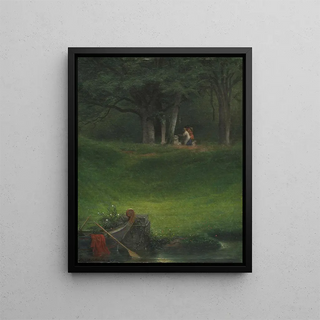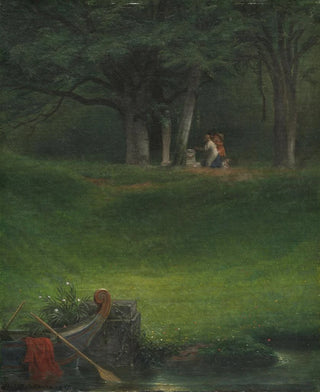Art print | Offering to the god Pan - Paul Delaroche


View from behind

Frame (optional)
In the rich and vibrant landscape of 19th-century art, Paul Delaroche's "Offering to the god Pan" stands out for its captivating atmosphere and narrative depth. This canvas, which depicts a mythological scene, transports us to a world where the divine and the earthly meet. Delaroche's choice to portray this moment of devotion not only demonstrates his technical talent but also his ability to capture the very essence of human emotions. As viewers contemplate this work, they are invited to feel the fervor of the offering and to immerse themselves in the spirituality emanating from each character. The artist manages to create a dialogue between the sacred and the profane, making this piece disturbingly modern despite its roots in classical tradition.
Style and uniqueness of the work
Paul Delaroche's style is characterized by meticulous attention to detail and a rich, nuanced color palette. In "Offering to the god Pan," each element is carefully considered to enhance the storytelling. The faces of the characters, imbued with sincerity and emotion, reveal a profound humanity that transcends time. The light, subtly illuminating the scene, plays a crucial role in highlighting textures and forms. The drapery, flowing and elegant, adds an almost tactile dimension to the work, while the landscape in the background, both idyllic and wild, evokes the untamed nature represented by Pan. This canvas is not merely a simple illustration of a myth; it becomes a true portrait of the human soul, exploring themes of devotion, love, and spiritual quest.
The artist and his influence
Paul Delaroche, an emblematic figure of French Romanticism, knew how to mark his era with an innovative approach to historical painting. By integrating narrative and emotional elements into his works, he paved the way for a new way of perceiving art. His influence extends far beyond his time, inspiring many artists who followed in his footsteps. "Offering to the god Pan" is a perfect example of

Matte finish

View from behind

Frame (optional)
In the rich and vibrant landscape of 19th-century art, Paul Delaroche's "Offering to the god Pan" stands out for its captivating atmosphere and narrative depth. This canvas, which depicts a mythological scene, transports us to a world where the divine and the earthly meet. Delaroche's choice to portray this moment of devotion not only demonstrates his technical talent but also his ability to capture the very essence of human emotions. As viewers contemplate this work, they are invited to feel the fervor of the offering and to immerse themselves in the spirituality emanating from each character. The artist manages to create a dialogue between the sacred and the profane, making this piece disturbingly modern despite its roots in classical tradition.
Style and uniqueness of the work
Paul Delaroche's style is characterized by meticulous attention to detail and a rich, nuanced color palette. In "Offering to the god Pan," each element is carefully considered to enhance the storytelling. The faces of the characters, imbued with sincerity and emotion, reveal a profound humanity that transcends time. The light, subtly illuminating the scene, plays a crucial role in highlighting textures and forms. The drapery, flowing and elegant, adds an almost tactile dimension to the work, while the landscape in the background, both idyllic and wild, evokes the untamed nature represented by Pan. This canvas is not merely a simple illustration of a myth; it becomes a true portrait of the human soul, exploring themes of devotion, love, and spiritual quest.
The artist and his influence
Paul Delaroche, an emblematic figure of French Romanticism, knew how to mark his era with an innovative approach to historical painting. By integrating narrative and emotional elements into his works, he paved the way for a new way of perceiving art. His influence extends far beyond his time, inspiring many artists who followed in his footsteps. "Offering to the god Pan" is a perfect example of






